- Submissions

Full Text
COJ Robotics & Artificial Intelligence
Methods and Strategies for Search Engine Optimizatio
Maitra S1, Sahoo L2* and Tiwary K3
1Department of Computer and Information Science, Raiganj University, India
2Department of Computer and Information Science, Raiganj University, India
3Department of Mathematics, Raiganj University, India
*Corresponding author: Sahoo L, Department of Computer and Information Science, Raiganj University, India
Submission: July 15, 2022;Published: August 10, 2022

ISSN:2832-4463 Volume2 Issue2
Abstract
Using search engines to find information is a very significant and necessary aspect of our daily lives and most of the online information can always be retrieved through search engines. It takes a lot of work to get a website to the top of a search engine’s results, therefore we employ several Search Engine Optimization (SEO) techniques to make it user-friendly. The main goal of each and every website owner’s is to provide their website appear at the top of all results on Search Engine Results Pages (SERPs). The practice of making a website more visible on search engine results pages is known as search engine optimization. SEO techniques are used to enhance the ranking of the web site and make it visible to the search engine. Depending on the rankings our web site will be placed in the search results. The main focus of this study is to make web site be visible only on top few result pages/places of the search result. So as to improve their appearance in a website, SEO make use of better ranking in the search result using the keyword selection and usage, high quality back links, rational website constitution, meta tags and rich content. Here, we have discussed several optimization schemes for the improvement of a website. Some SEO techniques studied in this paper are ON Page SEO, OFF Page SEO, Black Hat, White Hat and Grey hat techniques. This paper provides an in-depth examination of how a Search Engine (SE) functions, types of search engines, and various tools and strategies used for search engine optimization.
Keywords: Search Engine Optimization (SEO); SEO techniques; Page rank; White hat SEO; Black Hat SEO
Introduction
These days, the vast content of the Internet has made it arduous to retrieve proper information on a subject. Techniques/methods for retrieving information have become really more important [1]. The phrase “information retrieval” was first used in 1950s, but concepts relating to the organization, storage, and retrieval of information, typically in the context of library materials, had existed for much longer. The world wide web is a commonly exploited global information process in which individuals use Search Engines (SE) to look up crucial data. The SE is a group of software that integrates the information gathered from all around the internet [2]. Using SE, individuals who are seeking information just need to type in a keyword for what they would want to see, and the search engine will then offer links to content that closely matches what they are looking for. Hence, search engine becomes very indispensable and important part of our everyday life to search information. We always depend on search engines to dispense us precise information at right time and right places. To meet the users, demand search engine must detect and clarify most linked information analogous to the user query and exhibit that information to the user. If the search engine impartially infers feature and importance of every page and return high quality pages to the user then “search-enginebias” may not be a serious problem [3].
However, superiority of page is very subjective presumption and very formidable task to estimate in the reality. Google is the most well-known and often used SE on the internet, where most of the peoples worldwide utilizing it to do informational web searches [2,4]. Besides that, there are a number of popular Search Engines on the internet viz. Dogpile, Baidu, Bing, Yahoo, Ask etc. [2]. Each and every web search engine strives to find and aggregate garbled data on the internet. Just before arrival of any search engines, users had to browse an array of File Transfer Protocol (FTP) websites in order to access particular shared resources [5]. As more and more web servers entered the internet over time, there has been an essential expectation for arranging and retrieving distant data files on File Transfer Protocol (FTP) web servers [6]. As a result, the need to more successfully and easily explore the FTP web servers and data on the Internet led to the development of search engines [5]. Table 1 shows top 10 most popular search engine in the world. Every website owner wants to have their website appear at the top of the search engine result pages; hence they choose to apply SEO strategies [7].
Table 1: Top 10 most popular search engine in the world.

In order to rank as highly as possible in search engine result pages, SEO involves optimizing an entire website or a select number of web pages to make them accessible for search engine crawlers. Search Engine Optimization is the process of increasing both the quantity and the quality of link building to any website [7,8]. Knowing the quantity and quality of traffic and genuine results is important for a better understanding of SEO. Higher value of page rank implies that the website is very popular and high in demand [9]. For the sake of attaining a higher rank in search engine out comes several websites up gradation techniques are employed by the website designers. The exertions that are discharged by SEO to increase the amount of targeted traffic that comes to a website through a search engine. It encompasses items like making changes to the text and the HTML code. It also appends face to face communication with the search engine by making choices for listings or links. To popularize the website several search engine optimization techniques are used by website designers.
Search Engine Optimization (SEO) [10] is the process which refines the volume and quality of traffic to a web site from search engines over natural search results for specified keywords. Search engine optimizers use knowledge base SEO and knowledge base SEO is a vital aspect for the purpose of customer support strategy. This is domain knowledge which estimates interestingness patterns from search result [11]. Search engine optimizers use search engine optimization techniques which obey search engine instructions are called white hat SEO techniques. Occasionally search engine optimizers use website promotion techniques in web page development which does not obey the search engine guidelines [12]. Such techniques are called black hat SEO techniques. The most vital SEO element for each and every search engine is the keyword with which the search strings are matched. Selecting the right keyword is the basic need to a successful SEO [13]. The most common SEO technique is the On page and Off page SEO.
The On page SEO share out with the keyword analysis (Figure 1), how a specific keyword is to be utilized. It also involves writing Meta tags. The purpose of Meta tag is to provide a description to the search engine about the content of a web page. The Meta tags also include Meta title, Meta keyword and Meta description. The Off page SEO deals with link building [14] with which a web site is promoted to other web sites. It also includes back links which is helpful to check the interestingness of the users who visit the web site. Here, we have discussed the characteristic of search engines viz. Page ranking (Figure 2) algorithm, Hilltop algorithm, ON Page SEO, OFF Page SEO, Black Hat, White Hat and Grey hat techniques. We have also studied about Meta tags, Meta title, Meta keyword and Meta description. Every website owner wants to have their website appear at the top of the search engine result pages; hence they choose to apply SEO strategies [7]. In order to rank as highly as possible in search engine result pages, SEO involves optimizing an entire website or a select number of web pages to make them accessible for search engine crawlers. Search Engine Optimization is the process of increasing both the quantity and the quality of link building to any website [7,8]. Knowing the quantity and quality of traffic and genuine results is important for a better understanding of SEO. The role of a Search Engine (SE), different search engine types, and numerous tools and SEO strategies are all extensively examined in this study.
Figure 1:Block diagram of Search Engine Optimization.
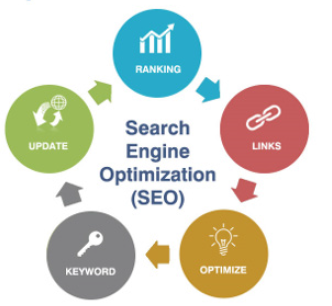
Figure 2:How search engine works.
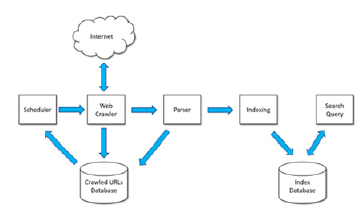
Design of a Search Engine
Figure 3:Framework of SEO.
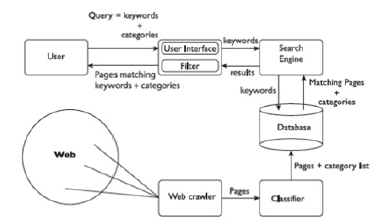
Generally, when a client takes part in a search query into a web crawler [15], it is a couple keywords. The web index has the names of the destinations holding the keywords, and these are in a flash acquired from the file. The original preparing load is in fabricating the site pages that are the search items list. Each and every page in the complete rundown must be weighted by data in the web indexes. Then the top search query output requires the lookup, reproduction, and markup of the fragments demonstrating the setting of the keywords synchronized. These are just piece of the preparing each indexed lists page requires, and additionally pages (alongside the top) require a greater amount of this post handling [16]. The design of a search engine can be seen in Figure 3.
How do search engines continue operating?
The main goal of any search engine is to find the desired information from huge databases of internet resources [17]. Search engines are a key strategy for identifying the information that we need online [18]. It does not really important where on the internet the data is stored. It is so that Search Engines can gather information from various parts of the web [19]. The popularity of using the internet has increased recently due to the browser search engines. SEs are divided into four main types based on how they work [18,20]. These are (i) Crawler-based SE (ii) Human-Powered Directories (iii) Hybrid SE and (iv) Other types of search engines. Figure 3 shows deep insight on how a search engine works.
Crawler-based SE
Individual web pages are retrieved by the crawler, which then extracts keywords before adding the pages to the database of the search engine. Google, Baidu, Yandex, Bing, Yahoo etc. are examples of crawler search engines.
Human-powered directories
Subject-based search engines with a human component are called human powered directories. The directories do not contain the complete content of the webpages they link to and are less comprehensive than most search engines. These directories are useful for those who are interested in a broad search topic.
Hybrid SE
Search results from directories and crawler-based results are combined in hybrid search engines. These days, a considerable number of search engines are migrating to a hybrid-based strategy. Google and Yahoo are examples of hybrid search engines.
Other types of search engines
There are various other SE categories that are dependent on usability in addition to the three basic SE types discussed above, such Crawler-based SE, Human-Powered Directories, and Hybrid SE. There are various varieties of SEs, but some of them mainly provide local listings, news, photos, products, and certain types of malwares. The best evidence is the Google News website, which can only be used to search news that has been published in a number of different newspapers worldwide. To provide Meta information about a web page in the search results, other kinds of SEs, such as Dogpile, are utilized to gather it from other directories and SEs.
Some search engine algorithms
Here, we have discussed two well-known search engine algorithms. One is Page Rank (PR) algorithm and other one is Hilltop Algorithm.
Page Rank (PR) algorithm
Page Rank algorithm is an algorithm where numerical weight is assigned to a webpage conforming to its relative importance (Figure 4). It utilizes incoming link information to assign global importance score to all pages on the web. Number of incoming links from standard sites calculates the popularity of a page. It is based on both quantity and quality of inbound and outbound links. Pages which have top most rank are much important and it has possibility to be listed on search engine’s top result list. Page rank value is grouped into levels 1-10 of which 10 represent higher PR value means that page is more popular in the web. On the other hand page rank value 1 represent lower PR value means page is not popular in the web. Assuming that T1,T 2,....Tn are pages linking to the page A then Page-A has its PR value computed as follows:

Where is damping coefficient, generally its value is taken as 0.85.
PR(Ti),I= 1,2,....,n is the PR value of Page- (Ti), C(Ti),I= 1, 2,...,n means number of outgoing links page (Ti),
Figure 4:Google page rank.

Hilltop algorithm
When a query is identified, Hilltop first calculate list of most relevant experts on the query subject matter. After that Hilltop recognize relevant links within the chosen set of experts and follow them to identify target web pages. In accordance with number and relevance of non-affiliated experts that point to them, target pages are ranked. So the score of a target page exhibits the collective opinion of the suitable independent experts on the query related matter. If expert’s opinion is not accessible, then Hilltop provides no results. Thus, Hilltop is adjusted for result accuracy and not for query coverage. Hilltop is topic sensitive (Figure 5) and generate list of authoritative pages on topic of the query. Each page is given a weight on binary scale. Value “1” represent best relevant page on the topic and “0” indicate not relevant or not found. Hence, Hilltop is for result accuracy and not for query coverage. Here, we compute the score of an expert as a 3-tuple of the form (S0, S1, S2) . Let k be the number of terms in the input query q. The component S i of the score is calculated by considering only key phrases that contain k-i of the query terms.

Figure 5:Topic Sensitive search.

where Level Score(p) is a score assigned to the phrase by virtue of the type of phrase it is. Fullness Factor(p, q) is a measure of the number of terms in p covered by the terms in q. Let be the length of p and m be the number of terms in p which are not in q. then fullness factor (p, q) is computed as follows:

Types of Search Engine Optimization
Generally, we may classify the search engine optimization techniques into two parts. These are (i) On Page SEO and (ii) Off Page SEO.
On page SEO
On Page search engine optimization is the most important part in the process of SEO. On page SEO basically makes use of the SEO components that web designers have got direct impact on it. On Page SEO is the art of rearranging the contents of a website such that it becomes search engine friendly. This technique includes the optimization of texts, graphics, HTML tags, URL structure, hyperlinks; headings etc. These SEO factors are analyzed more by search engines, than to off-page factors, to determine search result rankings [21].
Some On Page SEO Elements are as follows:
A. Title Tag: The title tag is truly important for quality
ranking of search engine. Search engine crawl the content of
this tag on the basis of preference. A page title is the first item,
a search engine will look.
B. Meta Tag: There are two fundamentals Meta tags are used
in Search Engine Optimization, that is keyword and description
tag.
C. Alt Attribute: Search engine only reads the alt attribute of
the image tag.
D. Header tags (H1, H2 and H3): HTML Heading Tags are
equally important for search engine point of view.
E. Permalinks of Web Pages: The Permalink is also called
URL (uniform resource locator) of a webpage. It should be
keyword oriented and SEO friendly.
F. Internal Linking: Internal Links are hyperlinks that point
to the same domain. This factor is also important for search
engine point of view.
G. Keyword Density: Keyword Density is the percentage of
times a keyword or phrase appears on the web page compared
to the total number of words on the page. Keyword Density is
really important in terms of SEO.
H. Sitemap: In Sitemap, all important website links are
available with date and updated information of page.
Off page SEO
Off-page SEO contains many techniques that are employed for creating inbound links to a webpage to increase the anticipated popularity of the page in view of search engine optimization algorithms [22]. This is the technique for producing back links. Back links are usually termed as link back from another website to our website. Back links are very important for SEO because search engine algorithms give acclaim, if any website has large number of back links. As well as back links increase, website popularity will increase. Some Important components of Off Page SEO are Link Building, Article Writing, Blog Publishing, and Social Media Bookmarking. This means how active is the website among several social media viz. Digg, Facebook, Google+, Twitter, Linked and many others. The active presence of a website over popular social media increases the brand value as well as reputation of the website. On page and Off page SEO are represented in Figure 6.
Figure 6:On Page SEO vs. Off Page SEO.
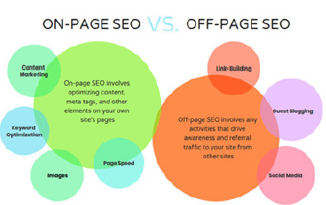
Some Others SEO
In this section we have presented some SEOs which are very useful for optimizing the web. These are White Hat SEO, Black Hat SEO and Gray Hat SEO.
White hat SEO
The conventional and finest way to optimize any website is called White Hat SEO. This kind of optimization is well supported and appreciated by all search engines; mainly by Google White Hat SEO technique is usually to achieve better results, if the website is updated regularly with quality and unique content. This means that the webmaster does not take a single attempt to misguide search engine and does not try to escape. Some features of White hat SEO techniques are showing in Figure 7.
Figure 7:Features of White hat SEO.
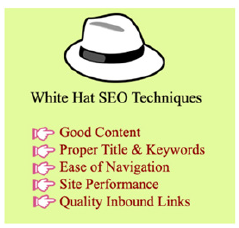
Black hat SEO
If a webmaster or optimizer is doing spamming in link building or making irrelevant links with some irrelevant recess websites, this will be considered as Black Hat SEO Technique. This technique of SEO is very high-risk for long term results because as the regular updates in search engine algorithm crawler will easily judge the spammed techniques to optimize websites. Some features of Black hat SEO techniques are showing in Figure 8.
Figure 8:Features of Black Hat SEO techniques.

Gray hat SEO
If the webmaster or optimizer uses some irrelevant techniques to optimize their website is known as GRAY HAT SEO technique. More simply we can say if the optimizer may buy or exchange links with other websites to get better search engine ranking but it will be not accepted by the search engines. This technique is not long term for search engine ranking. Gray hat SEO techniques are depicted in Figure 9.
Figure 9:Gray hat SEO.
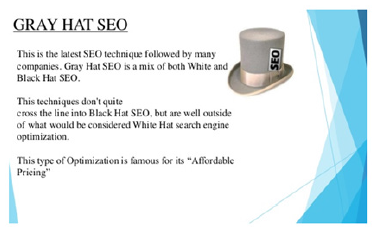
Tools for Search Engine Optimization
In order to increase a webpage’s natural search position and find new ways to develop content that will actually help the business, SEO methods should be ongoing efforts. If a website is not constantly checked, the search engine ranking will deteriorate [23]. As a result, it is indeed essential to complete ongoing SEO tool analysis. On the internet, there are a variety of paid and unpaid SEO tools that provide a variety of purposes and take care of some basic requirements. Some of the tools are practical, simple, and quick. Some essential SEO tools are Google Search Console, Bing Webmaster Tools, BROWSEO, Google analytics tool, Screaming Frog, GTMetrix, Rank Checker, Google Trends, Google AdWords, Wayback Machine, Moz, Google Recommendations etc.
Advantages of Search Engine Optimization
Some advantages of SEO are as follows:
Popularity: Using SEO technique popularity will increase.
Increase Visibility: If a website has been optimized immediately,
it will increase the visibility of website in search engine.
Targeted Traffic: Search Engine Optimization can increase the
number of visitors to the website for the targeted keywords.
High Return of Investments: An effective SEO effort can bring a
high return of investment than any other marketing. It will increase
the volume of sales.
Other benefits of SEO have been shown in Figure 10.
Figure 10: Pictorial representation of SEO Benefits.
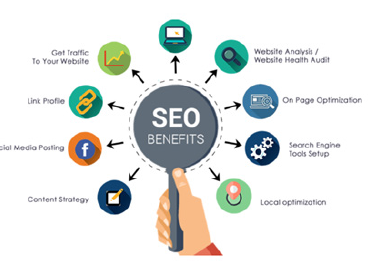
Concluding Remarks
In fact, search engines are a helpful tool in the continuous development of web. Although there are various search engines on the market, Google is the most prominent one. Designers must therefore utilize search engine optimization techniques and SEO algorithms in order to obtain the top results on the web. The Hilltop Algorithm and Page Rank (PR) Algorithm are two popular SEO algorithms for web searches. For higher search results, both on-page and off-page search engine optimization tactics are crucial. Additionally, three SEO components-White Hat SEO, Black Hat SEO, and Grey Hat SEO techniques-are taken into account. White hat SEO is the most effective and long-lasting among them. In all three types of Search Engine Optimization techniques, the White Hat SEO is safest and long-lasting. In addition, White Hat Search Engine Optimization techniques is best for securing the top ranking on Search Engine Result Pages. Both the on-page and off-page Search Engine Optimization techniques are essential for excellent search results. The process includes a SE spider downloading a webpage and saving it on the server of Search Engine, where indexer extracts the several necessary information about the webpage, e.g., words on a webpage, the location of words, weight for particular words and, incoming and outgoing links on the webpage. For crawling later, all these are placed in a scheduler. Owners of the websites and SEO professionals already recognized the importance of high web ranking and visibility of their contents on Search Engine Result Pages, therefore for achieving the excellent results in minimum time they started to use of Search Engine Optimization Tools. SEO tools are best for keeping an eye on the website for SEO related issues.
References
- Belsare S, Patil S (2012) Study and evaluation of user’s behaviour in e-commerce using data. Research Journal of Recent Sciences, 1(ISC-2011): 375-387.
- Sullivan D (2002) How search engines work. SEARCH ENGINE Watch.
- Cho J, Roy S (2004) Impact of search engines on page popularity. Proc 13th International conference on World Wide Web pp. 20-29.
- Convey E (1996) Porn sneaks way back on web. Bost Her 28.
- Seymour T, Frantsvog D, Kumar S (2011) History of search engines. International Journal of Management & Information Systems 15(4): 47-58.
- Robertson S (2019) A brief history of search results ranking. IEEE Annals of the History of Computing 41(2): 22-28.
- Shahzad A, Nawi N M, Hamid NA, Khan SN, Aamir M, et al. (2017) The impact of search engine optimization on the visibility of research paper and citations. International Journal of Informatics Visualization 1(4-2): 195-198.
- Giomelakis D, Veglis AA (2019) Search engine optimization. Advanced Methodologies and Technologies in Network Architecture Mobile Computing and Data Analytics, IGI Global, Pennsylvania, United States, pp. 1789-1800.
- Knezeric B, Vidas-Bubanja M (2010) Search engine marketing as key factor for generating quality online visitors. Proc 33rd International Convention MIPRO, Opatija, Croatia, pp. 1193-1196.
- Jain A (2013) The role and importance of search engine and search engine optimization. International Journal of Emerging trends & Technology in Computer Science 2(3): 99-102.
- Raorane AA, Kulkarni RV (2012) Association rule-extracting knowledge using market basket analysis. Research Journal of Recent Sciences 1(2): 19-27.
- Bhandari RS, Bansal A (2018) Impact of search engine optimization as a marketing tool. Jindal Journal of Business Research 7(1): 24-36.
- Poongkode JPS, Nirosha V (2014) A study on various search engine optimization techniques. International Journal of Innovative Research in Computer and Communication Engineering 2(11): 6738-6742.
- Zhang S, Cabage N (2016) Search engine optimization: Comparison of link building and social sharing. Journal of Computer Information Systems 57(2): 148-159.
- Thelwall M (2015) Web crawlers and search engines. In: Jens-Erik Mai (Ed.), Link analysis: An information science approach. Emerald Group Publishing Limited, United Kingdom.
- Harter S, Hert C (1997) Evaluation of information retrieval systems: Approaches, issues, and methods. Annual Review of Information Science and Technology 32(1): 3-94.
- Ali AA, Shafi RM (2019) Test-retrieval framework: performance profiling and testing web search engine on non-factoid queries. Indonesian Journal of Electrical Engineering and Computer Science 14(3): 1373-1381.
- Halavais A (2017) Search engine society. John Wiley & Sons, New York, USA, pp. 240.
- Gajendragadkar U, Joshi S (2017) Context sensitive search string composition algorithm using user intention to handle ambiguous keywords. International Journal of Electrical and Computer Engineering 7(1): 432-450.
- Green EA, Markey KL, Kreider M (2016) Subject matter context search engine. Google Patents.
- Luh CJ, Yang SA, Huang TLD (2016) Estimating google’s search engine ranking function from a search engine optimization perspective. Online Information Review 40(2): 1-29.
- Sen R (2005) Optimal search engine marketing strategy. International Journal of Electronic Commerce 10(1): 9-25.
- Kim S, Park H, Lebanon G (2014) Fast spammer detection using structural rank, pp.1-8.
© 2022 Sahoo L. This is an open access article distributed under the terms of the Creative Commons Attribution License , which permits unrestricted use, distribution, and build upon your work non-commercially.
 a Creative Commons Attribution 4.0 International License. Based on a work at www.crimsonpublishers.com.
Best viewed in
a Creative Commons Attribution 4.0 International License. Based on a work at www.crimsonpublishers.com.
Best viewed in 







.jpg)






























 Editorial Board Registrations
Editorial Board Registrations Submit your Article
Submit your Article Refer a Friend
Refer a Friend Advertise With Us
Advertise With Us
.jpg)






.jpg)














.bmp)
.jpg)
.png)
.jpg)










.jpg)






.png)

.png)



.png)






